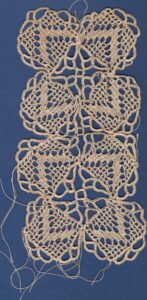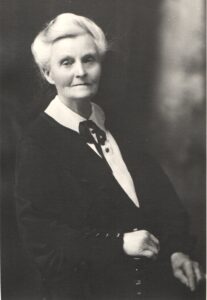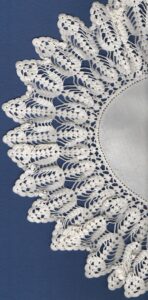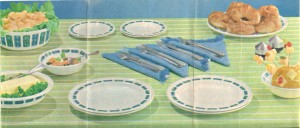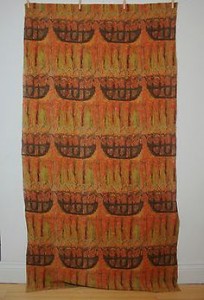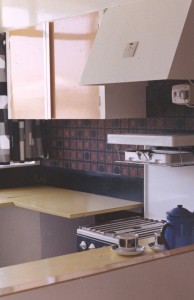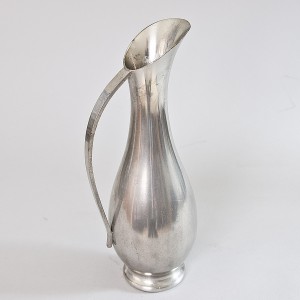Archive for the ‘textiles’ Category
A legacy of crocheted lace
A comment in an old letter to my mother catches my eye:
March 1, 1971
I can’t remember anything about that bit of crochet, Mum, but I guess it probably is mine. Now it will sit in my workbox for years!
Do I still have it? I open the Cadbury’s Chocolate box that holds my collection of crochet hooks and sundry balls of crochet thread. On top sits a small piece of lace, obviously the beginnings of an ambitious project. Was it the piece that cluttered Mum’s workbox? Probably.
The art of crochet was honored in my mother’s family, passed on, like all domestic arts, from generation to generation. The most noted expert was my great-grandmother, Sarah Jane Caundle, whom I met a few times when I was a child. She was born in 1864 to Irish immigrants on a New Zealand goldfield. In a reminiscence my mother wrote:
Outside the back door [of Grandma’s house] in the sun was a stool to sit on. Across the yard in a shed that housed the wash house with its copper and wooden tubs with the toilet next to it. Grandma washed the clothes in the old way with a well-stoked fire under the copper to boil the sheets, etc. The tubs for the rinsing and blueing with a hand-turned wringer between them. While visiting as a small girl I was being taught how to crochet. Trying to make my doll a pink woolen petticoat like the ones Grandma made for us. Something would not go right so I called for assistance. There was Grandma coming across the yard at her usual jog-trot wiping the soapsuds off her arms on her apron (Must always wear an apron) to sort out my muddle. The picture is still so clear in my mind.
… As we grew older we were given doilies and crochet-edged linen for our “box.” At each 21st birthday each granddaughter was presented with an afternoon tea cloth with a wide edge of crochet lace.
Before she died in 1951, Great-Grandma Caundle had started making doilies for her great-granddaughters. I missed out, but inherited a piece of her work from my mother. Fascinated by Mum’s stories about her grandmother’s life, I put together a poem:
Great-Grandma’s Doily
Early afternoon, when chores were done,
Great-Grandma put her feet up on the kitchen couch
and gave herself an hour with crochet hook and thread
to figure out the sequence from a photograph—
chain and double loop and treble—
the mathematical progression of the rounds
revealing patterns satisfying in their laciness.
She learned the art at her mother’s knee
in the dirt-floored hut at the Puriri claim.
Her mother learned it from her Mam
back in Ireland before famine memories
and rumors of gold in the far-off colonies
took Bernie Donnelly and his new young wife
adventuring across the world.
There was a dame school at the diggings.
Great-Grandma might have gone some days
but not enough for fluency in letters.
She had sisters and brothers to mind,
manuka-twig brooms to fashion for the floor,
clay to fetch for the hearth’s weekly whitewash of mud.
She entered service as a housemaid at eleven.
Later came marriage and children of her own,
nine of them, then grandchildren to care for.
All this time persisting in her art,
gifting to daughters and grand-daughters
lacy linens for their marriage chests.
I have one doily, handed down, an oval of white linen
edged with a crocheted frill of tulips in a row,
each stitch pulled neat and tight, a testament
to discipline and practice, and the will
to make time for her art.
Furnishing a house, 1960s style
A magazine clipping tumbles from a November 1964 letter from England to my parents. It’s the picture of a dinner service I won in a menu-planning competition. Looking at the geometric pattern on the dishes, I realize that the way we furnished the row house we bought that year has many elements of what is now recognized as a distinctive 1960s aesthetic: bold shapes and strong colors.
Having limited funds, Tony and I refurbished or made many pieces of furniture. The dining table he made was a heavy white plastic-veneered slab with straight, varnished wood legs. He built, and I upholstered, a sofa and side chairs with squared-off, simple lines, a copy of a set we particularly liked, but whose price was prohibitive. I made all the curtains from fabric purchased at Heal’s of London, the store that carried the trendiest of household furnishings. I wrote:
8 August 1964
The sitting room curtains are quite magnificent – deep orange flame colour, with a pattern called “Armada,” the formalised ships’ hulls giving the impression of a dark horizontal stripe.
A shag (another 1960s design element) area rug that matched the curtain’s colors helped warm up the coldness of the room. After battling the developer over the house’s color scheme, we had compromised on gray vinyl tile floor and plain white walls. In the kitchen and dining area, we covered the white with a geometric wallpaper. A photograph reveals more geometrics: the gray and white kitchen curtains, the cups and saucers on the counter.
We still have one platter from that dinner service I won. A few other items, mainly metal, have survived the years. A pewter jug purchased on board ship during our emigration from New Zealand to England still sits on our kitchen windowsill. To the right of the dinner service picture, behind a porcupine of cheese chunks on skewers, are familiar objects: salt and pepper shakers just like the ones we still use every day. I guess we, like these furnishings, can all be labeled “vintage.”
